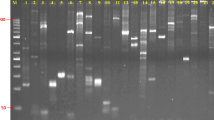Abstract
In this report we describe the use of five oligonucleotide probes, namely (GATA)4, (GACA)4, (GGAT)4, (GAA)6 and (CAC)5, to reveal highly polymorphic DNA regions in rice. With each of the oligonucleotide probes, the level of polymorphism was high enough to distinguish several rice genotypes. Moreover, individual plants of one cultivar showed the same cultivar-specific DNA fingerprint. The multilocus fingerprint patterns were somatically stable. Our study demonstrates that microsatellite-derived DNA fingerprints are ideally suited for the identification of rice genotypes. As the majority of the probes detected a high level of polymorphism, they can be very useful in monitoring and aiding gene introgression from wild rice into cultivars.
Similar content being viewed by others
References
Ali S, Muller CR, Epplen JT (1986) DNA fingerprinting by oligonuc-leotide probes specific for simple repeats. Hum Genet 74:239–248
Amante-Bordeos A, Sitch LA, Nelson R, Dalmacio RD, Oliva NP, Aswidinnoor H, Leung H (1992) Transfer of bacterial blight and blast resistance from Oryza minuta to cultivated rice, Oryza sativa. Theor Appl Genet 84:345–354
Beyermann B, Nurnberg P, Weihe A, Meixner M, Epplen JT, Borner T (1992) Fingerprinting plant genomes with oligonucleotide probes specific for simple repetitive DNA sequences. Theor Appl Genet 83:691–694
Buitkamp J, Kuhn C, Zischler H, Epplen JT, Geldermann H (1991) DNA fingerprinting in cattle using oligonucleotide probes. Anim Genet 12:169–174
Dallas JF (1988) Detection of DNA “fingerprints” of cultivated rice by hybridization with a human minisatellite probe. Proc Natl Acad Sci USA 85:8631–6835
Ellegren H, Andersson L, Johansson M, Sandberg K (1992) DNA fingerprinting using a simple (TG) n probe and its application to population comparisons. Anim Genet 23:1–9
Epplen JT (1988) On simple repetitive GATA/GACA sequences: a critical reappraisal. J Hered 79:409–417
George M, Lequarre AS, Catelli M, Hanset R, Vassart G (1988) DNA fingerprinting in domestic animals using four different minisatellite probes. Cytogenet Cell Genet 47:127–131
Goldshalk EB, Lee M, Lamkey KR (1990) Relationship of restriction fragment length polymorphisms to single cross hybrid performance of maize. Theor Appl Genet 80:273–280
Haberfeld A, Cahaner A, Yoffe O, Plotsky Y, Hillel J (1991) DNA fingerprints of farm animals generated by microsatellite and minisatellite DNA probes. Anim Genet 22:299–305
Hillel J, Schaap T, Haberfeld A, Jeffreys AJ, Plotzky Y, Cahaner A, Lavi U (1990) DNA fingerprints applied to gene introgression in breeding programs. Genetics 124:783–789
Jeffreys AJ, Wilson V, Thein SL (1985a) Hypervariable “minisatellite” regions in human DNA. Nature 314:67–73
Jeffreys AJ, Wilson V, Thein SL (1985a) Individual specific “fingerprints” of human DNA. Nature 316:76–79
Jena KK, Khush GS (1990) Introgression of genes from Oryza officinalis Well Ex. Watt to cultivated rice, O. sativa L. Theor Appl Genet 80:737–745
Kashi Y, Tikochinsky Y, Genislav E, Traqi F, Nave A, Beckmann JS, Gruenbaum Y, Soller M (1990) Large restriction fragments containing poly-TG are highly polymorphic in a variety of vertebrates. Nucleic Acids Res 18:1129–1132
Kochko AD, Keifer MC, Cordesse F, Reddy AS, Delseny M (1991) Distribution and organization of a 352-bp tandem repeat in Oryzae family. Theor Appl Genet 82:57–64
Lee M, Godshalk EB, Lamkey KR, Woodman WW (1989) Association of restriction fragment length polymorphisms among maize inbreds with agronomic performance of their crosses. Crop Sci 29:1067–1071
Nybom H, Hall HK (1991) Minisatellite DNA “fingerprints” can distinguish Rubus cultivars and estimate their degree of relatedness. Euphytica 53:107–114
Nybom H, Rogstad SH, Schaal BA (1990) Genetic variation detected by use of M13 “DNA fingerprint” probe in Malus, Prunus, and Rubus (Rosaceae). Theor Appl Genet 79:153–156
Rogers SO, Bendich AJ (1988) Extraction of DNA from plant tissues. In: Gelvin SB, Schilperoort RA (eds) Plant molecular biology manual A6:1. Kluwer Academic Publishers, Dordrecht
Rogstad SH, Patton JC, Schaal BA (1988) M13 repeat probe detects DNA minisatellite like sequences in gymnosperms and angiosperms. Proc Natl Acad USA 85:9176–9178
Ryskov AP, Jincharadze AG, Prosnayak MT, Tvanov PL, Limborska SA (1988) M13 phage DNA as a universal marker for DNA fingerprinting of animals, plants and microorganisms. FEBS Lett 233:388–392
Schafer R, Zischler H, Birsner U, Becker A, Epplen JT (1988) Optimized oligonucleotide probes for DNA fingerprinting. Electrophoresis 9:369–374
Tanskley SD, Young ND, Paterson AH, Bonierbale MW (1989) RFLP mapping in plant breeding — new tools for an old science. Bio/technology 7:257–264
Tautz D (1989) Hypervariability of simple sequences as a general source for polymorphic DNA markers. Nucleic Acids Res 17:6463–6471
Tautz D, Trick M, Dover GA (1986) Cryptic simplicity in DNA is a major source of genetic variation. Nature 322:652–656
Tsao SGS, Brunk CF, Pearlman RE (1983) Anal Biochem 131:365–372
Turner BC, Elder JF, Laughlin TF, Davis WP, Taylor DS (1992) Extreme clonal diversity and divergence in populations of a selfing hermaphroditic fish. Proc Natl Acad Sci USA 89:10643–10647
Vosman B, Avens P, Rus-Kortekaas W, Smulders MJM (1992) Identification of highly polymorphic DNA regions in tomato. Theor Appl Genet 85:239–244
Weising K, Beyermann B, Ramser J, Kahl G (1991) Plant DNA fingerprinting with radioactive and digoxy geneted oligonucleotide probes complementary to simple repectitive DNA sequences. Electrophoresis 12:159–169
Weising K, Kaemmer D, Weigand F, Epplen JT, Kahl G (1992) Oligonucleotide fingerprinting reveals various probe dependent levels of informativeness in chick pea (Cicer arietinum). Genome 35:436–442
Wetton JH, Carter RE, Parkin DT, Walters D (1987) Demographic study of a wild house sparrow population by DNA fingerprinting. Nature 327:147–149
Zehr BE, Dudley JW, Chojecki J, Saghai Maroof MA, Mowers RP (1992) Use of RFLP markers to search for alleles in a maize population for improvement of an elite hybrid. Theor Appl Genet 83:903–911
Zischler H, Nanda T, Schafer R, Schmid M, Epplen JT (1989) Digoxygenated oligonucleotide probes specific for simple repeats in DNA fingerprinting and hybridization in situ. Hum Genet 82:227–233
Author information
Authors and Affiliations
Additional information
Communicated by P. M. A. Tigerstedt
Rights and permissions
About this article
Cite this article
Ramakishana, W., Lagu, M.D., Gupta, V.S. et al. DNA fingerprinting in rice using oligonucleotide probes specific for simple repetitive DNA sequences. Theoret. Appl. Genetics 88, 402–406 (1994). https://doi.org/10.1007/BF00223651
Received:
Accepted:
Issue Date:
DOI: https://doi.org/10.1007/BF00223651




